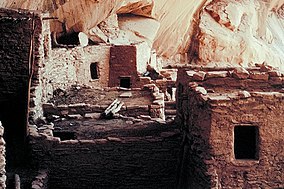Navajo National Monument
| Navajo National Monument | |
|---|---|
|
IUCN category V (protected landscape/seascape)
|
|

Keet Seel cliff dwellings
|
|
| Location | Navajo & Coconino counties, Arizona, USA |
| Nearest city | Kayenta, Arizona |
| Coordinates | 36°40′42″N 110°32′27″W / 36.6783318°N 110.5409720°WCoordinates: 36°40′42″N 110°32′27″W / 36.6783318°N 110.5409720°W |
| Area | 360 acres (150 ha) |
| Created | March 20, 1909 |
| Visitors | 87,388 (in 2011) |
| Governing body | National Park Service |
| Website | Navajo National Monument |
|
Navajo National Monument
|
|
| NRHP Reference # | 66000176 |
| Added to NRHP | October 15, 1966 |
Navajo National Monument is a National Monument located within the northwest portion of the Navajo Nation territory in northern Arizona, which was established to preserve three-well preserved cliff dwellings of the Ancestral Puebloan People: Broken Pottery (Kitsʼiil), Ledge House (Bitátʼahkin), and Inscription House (Tsʼah Biiʼ Kin). The monument is high on the Shonto plateau, overlooking the Tsegi Canyon system, west of Kayenta, Arizona. It features a visitor center with a museum, two short self-guided mesa top trails, two small campgrounds, and a picnic area. Rangers guide visitors on free tours of the Keet Seel and Betatakin cliff dwellings. The Inscription House site, further west, is currently closed to public access.
The Sandal Trail is an accessible self-guided walk that provides views of the spectacular canyonlands and rugged topography near the visitor center. Interpretive signs provide information on local flora and other topics. The 1-mile (1.6 km) round-trip trail ends at an overlook of the Betatakin ruins across the 560-foot-deep (170 m) Betatakin Canyon. The National Monument was listed on the National Register of Historic Places on October 15, 1966.
Keet Seel or Kiet Siel (Kįtsʼiil), which stands for "broken house" in Navajo, is a well preserved cliff dwelling of the ancient Anasazi people located in a branch of the Tsegi Canyon in the Kayenta region. The site was first occupied at around 1250, during a time in which a large number of people were believed to be aggregating in sites such as this in this part of the American Southwest. There was a construction boom at Keet Seel between 1272 and 1275, with construction then slowly tapering off and halting completely at 1286. Once construction halted in 1286, there was no evidence of structures being built until its subsequent abandonment some 20 years later. It is believed that, at its peak, up to 150 people inhabited this site at one time. Due to the extremely dry climate and natural overhanging cliff, the conditions at Keet Seel were quite optimal for excellent preservation of the site's dwellings and artifacts. Keet Seel is considered by many archaeological experts to be one of the best preserved larger ruins in the American Southwest.
...
Wikipedia

